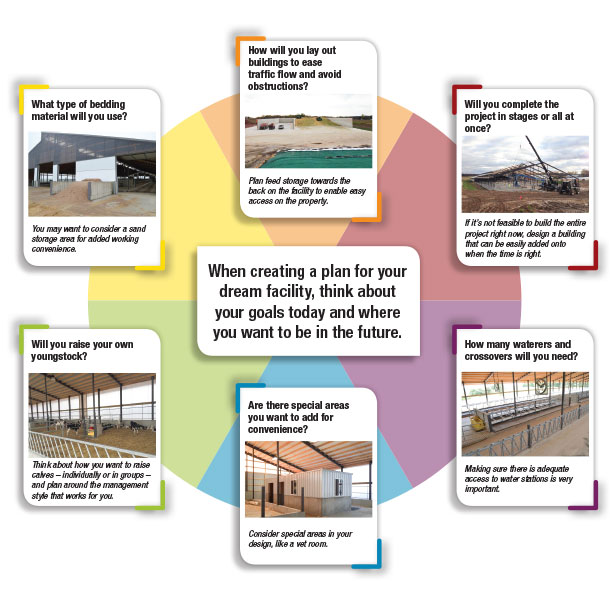Each producer has his or her own “idea” of what a dream facility may be. One person’s may be to expand because the next generation is going to enter the family farm, while another may be looking at how to cut a portion of labor out of their everyday routine.
Whatever your dream facility may entail, it revolves around what lifestyle and management practices you feel will suit your needs most.
Not one freestall barn or facility that we have built is exactly alike. This is due to each person’s own experiences and preferences. I have been on countless farm tours with producers during the designing phases of their future projects.
So often I hear one say, “This barn is amazing, but I would change this.” Or, “This is exactly what I want, but I want this a little different.” There is no one barn that is perfect for everyone. Simply put, each producer has his or her own way that works. We all know agriculture and dairying have many different management practices.
Create your plan
Ask yourself “What is my end goal?” In order to achieve this goal, you need to create a “now” plan, a five-year plan, a 10-year plan and so forth. While creating these plans, outlining the details will be key:
- What type of bedding works for you: sand bedding, compost bedding or mattresses?
- How do you prefer to manage your ventilation system?
- Is a serene area for calving of high importance to you?
- Are extra areas for bedding storage, turn-around areas or an additional equipment room a high priority to you?
- How many watering stations do you want in your barn?
- Do you plan to raise your own youngstock someday?
- Is group housing for your youngstock a priority, or do you feel individual attention is what works best?
There is no right or wrong; it is what will work for you. You need to know how you can take what you have, make what you want with it, and make it perfect for you and your management team. Some of the ideas above may be far from what you plan to do right now, but are they future goals?
If so, you should have them in your master plan. While creating the master plan, you should have a rough idea in mind for your site’s layout. The traffic flow of your layout is extremely important in the everyday activities that happen.
You need your layout to have the ability to flow at top convenience for your equipment. You do not want direct traffic flows to and from the feed storage to its destination, as well as manure to the field operations, to interfere with each other.
If there is a flaw in the navigating flow, chaos will be created. This chaos will cause an indirect strain on your profit, not to mention cause you a few gray hairs.
While creating your ultimate plan, it is important to figure out your end goal for herd size. What will it take to get you from your current state to where you dream of being? This will play a huge part in how big each calf area, youngstock barn, transition barn, heifer barn, milking cow barn, holding area, parlor and manure system will need to be.
Meet with the experts
When you meet with the design experts, your future plans should be taken into consideration during the designing phase. At the current time, if you only have the ability to build your freestall barn to a certain size because of financial or other reasons, do not get discouraged.
This is all part of the “plan.” Will this mean you need to build in phases to reach your goal by adding onto the new freestall barn you are building two years from now? If so, when choosing the barn placement for today, the area should allow for the addition in two years.
You do not want to limit your growth; a poorly planned manure pit or feed storage location can certainly do just that. It is a lot more cost-effective to remove one end wall versus having to construct a new barn with two end walls. This may seem like a common sense statement, but from my experience, I have seen it overlooked many times. Placement and layout of your operation are key.
Determine your management practices
While designing and building your dream facility, you need to consider your management practices and beliefs. Each operation has their own tune to what management practices are practical for them. Is milking your main focus, or is it a portion of the whole picture, such as incorporating cash cropping and other ventures into your master plan?
I always find it so intriguing to see how each of our customers manages their facilities. What makes one operation so successful can be completely opposite of what makes the next operation a success.
When trying to compare operations, two very successful customers come to mind for me. One has a true belief in no overcrowding. The operation is run to the fullest and has 4,500 cows with the exact 4,500 stalls.
They believe a perfect 1-to-1 ratio is what is needed. The bedding and feed are the best quality. Of course, along with the best comes higher expenses. But run the figures in whatever way you want, at the end of the day they are producing 32,000-plus pounds of milk.
The next customer manages a facility with 4,500 cows but manages to make their business a success with 4,000 stalls and what would be considered a good feed and bedding quality.
The second operation manages to produce 25,000 pounds of milk with a significant lower expense rate. Both producers are successful and profitable because their management practices align with their idea of what success is to them.
Neither management practice is the better way. The first producer running with the 1-to-1 ratio has to have the ability to have top-notch intake; the best food, great water access, the most comfortable rest space and very roomy feed space. By allowing for adequate area for the cow to move to and from the feed, water and rest area, you pay a higher premium; in return, you will receive a higher premium.
Identifying what fits your budget
It does not matter where I am – at a business conference, on the road with one of our agriculture sales representatives, in a meeting with our dairy design specialist and a future customer or at the county fair bidding on animals – the most common question that comes out of the mouth of everyone in the industry is this: What does it cost per stall to build? We can toss a number out there and give you an answer, but it definitely will not be accurate.
Cost per stall is a function of several variable factors based on your goals, management style and personal preferences:
- What style of barn do you plan to build?
- How many animals will it house? The bigger the barn, the lower the cost due to building efficiencies.
- What size beds do you prefer?
- How many crossovers and waterers do you require?
- What style of headlocks and freestalls do you want to utilize?
- What type of ventilation are you requesting?
- Is extra concrete and reinforcement a high priority to you?
When figuring true costs of your project, the “little things” add up. What you want and prefer versus what you need can sometimes break the bank. If you financially are at the point in your business where you can afford and justify adding the extra bells and whistles for convenience and self-satisfaction, then do so. You and you team deserve to enjoy the fruits of your labor.
There is no right or wrong dream facility. Plan for what will work best for you and your team. Create your plan and execute. A bump in the road will arise every now and again, but always stay focused on your ultimate goal and don’t be afraid to utilize professionals to help make your dream a reality. PD

Ashley Ambrosius
Bayland Buildings Inc.







